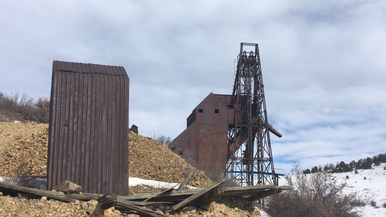
While returning from a visit to Glenwood Springs we stopped for gas in the sweet little Mountain town of Gypsum Colorado. Gypsum is a relatively new city, which celebrated its centennial in 1982. Unlike most of the towns in the region, it is not a mining town. In fact, its primary industry is agriculture, specifically potatoes.

I found this unique little two-story abandoned home captivating. You don’t normally see an abandoned home off a major intersection, next to a brand new service station. It turns out this property was occupied as soon as 2017. In fact, the last owner operated a taco truck off the land, it was appropriately “The Orange Taco Truck”. From what I understand it had amazing salsa, but the food trucks life was short lived.

The house dates back to the 1930’s; however; the adjacent cabin appears older. The cabin has been well kept and shows signs of recent restoration. While the home shows signs of neglect; buckling roof, ancient shingles, and likely filled with asbestos or led paint.
My best guess is this property was sold for redevelopment or was condemned by the city. Judging by the byt the age of the property and the size of the lot, I feel this house has more of a story to tell. Unfortunately, little records exist; however, I was glad to have captured the house before it is leveled and repurposed. If you know anything additional about the property and its history please comment below.
0 Comments

I had an amazing visit to Vindicator Valley and encourage you to also visit. However; be sure to call ahead to the main office (719-689-4220) to ensure no blasting is happening and you are ok to enter. Be sure that you obey all posted signs and enjoy. That being said; the “Vindicator Valley Trail” is one of the “Trails of Gold” outside of the town of Victor, CO. It is not a difficult trail but is distant from large cities. You can find lodging in Victor or Cripple Creek Colorado. Enjoy views of the Sangre de Cristo mountains and the countless abandoned mines, hoists, and buildings.

The Christmas Mine:
The first mine featured in the video is the Christmas mine. It was a privately held mine which began operations in the tum of the century. A portion of the claim was purchased by the Vindicator Consolidated Gold Mining Company in March of 1902. The Christmas Mine is reported to have produced gold valued at $1,335,000 or nearly 65,000 troy ounces during its life.... The shaft was reported to have eight levels with the lowest one at 605 feet below the surface (collar). The headframe was almost completely covered with development (or slack) rock from the Vindicator Mine until the 1980s when the frame we see today was exposed as the development rock was excavated and reprocessed. 
The Theresa Mine:
The Theresa Gold Mining Company owned and operated this mine from 1895 until 1900. The company was purchased by the Golden Cycle Mining Company after the turn of the century. Subsequently, the property was sold to the Vindicator Consolidated Gold Mining Company in 1922, the Vindicator Consolidated Gold Mining Company was purchased by the United Gold Mines Company whose properties later became part of the Golden Cycle Mining Company. The property was operated through the years by various sets of lessees alternating with years of idleness. Much of the rock dump was removed for processing in 1946 at the Golden Cycle mill in Colorado Springs. In 1986, additional portions of the dump were removed for slack-heap leaching, the slopes graded and partially reclaimed. Production records indicate that the mine produced over $2,500,000 in gold ore which comes to over 120,000 troy ounces. 
By 1920, the three-compartment Theresa shaft was 1620 feet deep and serviced by a Wellman, Seaver, Morgan double-drum steam hoist. Power was supplied by at least one 250 hp Babcock & Wilson water tube boiler. The four-post derrick type timber headframe stood over the shaft. Rock was transported through the shaft in mine cars on two small, double deck cages. The Theresa was idle from 1915 until a group of lessees took over and rehabilitated the mine in 1930. The group had to spile (a means of timbering to reinforce a tunnel) through waste filled stopes that had been mined into the shaft itself. The lessees retrofitted the steam hoist with a 75 hp, electric motor. Drill steels were sharpened in the Vindicator Mine shops and compressed air was supplied by the Teller County Air Company. The entire surface plant was destroyed by fire in 1934. The headframe was replaced with the present steel structure under the supervision of master mechanic, Bob Welsh. The plant was upgraded with a metal hoist house, a metal ore house incorporated into the headframe structure and a new change room. The shaft was equipped with a single but larger skip and a counterweight to provide balanced hoisting. Note that the overhead tramway is slightly inclined outward to the east, permitting cars of waste to roll out to be automatically dumped and then pulled back by a small hoist located in the ore house eliminating the need for one surface worker to do this work. Additional exploration carried out in 1961 failed to give promising results and, coupled with the closing of the Carlton Mill, led to the final closure of the Theresa Mine, in the 1980s, the Inactive Mined Land Reclamation Division stabilized the collar of the shaft, and in 1995, CC&V stabilized the ore bin foundation and added additional cribbing to the bank on the east of the headframe.
|
AuthorThank you for visiting! This is a collection of media from the lost and abandoned corners of the world. Please have a look around, I hope you enjoy. Archives
April 2022
Categories
All
|
Libraries |
Support |
|


